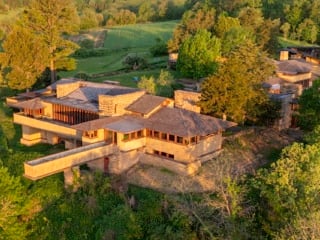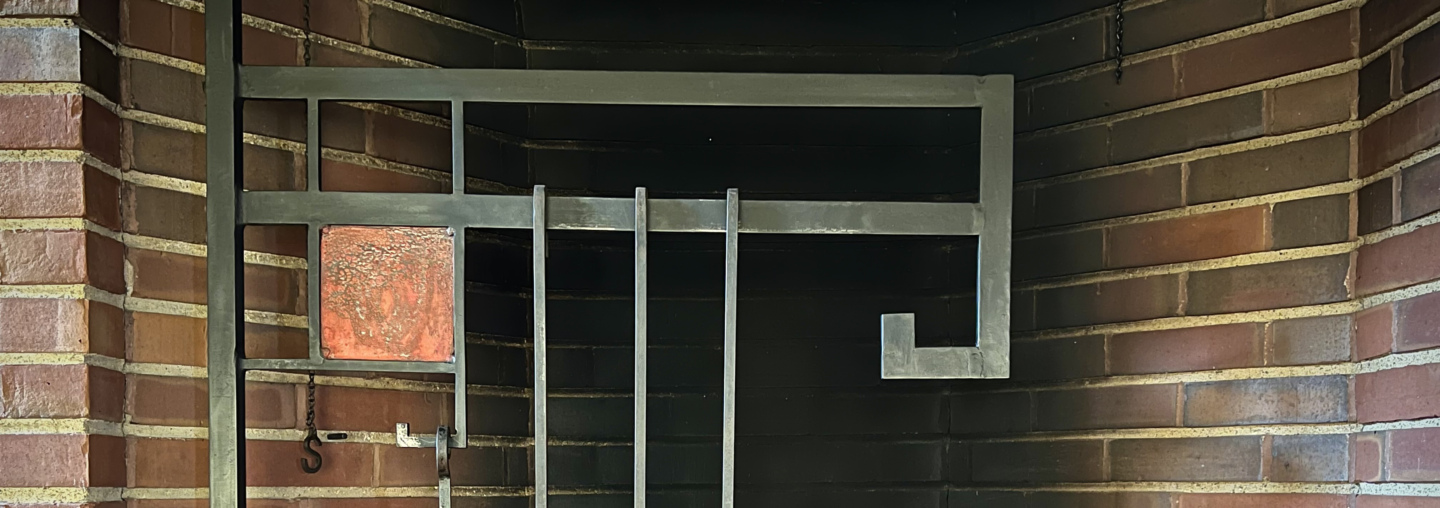
Willey House Stories Part 22: Calling the Kettle Back—Chapter 2: The Crane
Steve Sikora | Jan 13, 2023
In this seven-chapter subseries of the Willey House Stories, Steve Sikora reflects on Frank Lloyd Wright’s fireplaces, their purpose and meaning—and the search for one missing kettle. Subsequent chapters will follow over the next few weeks.
In my curiosity about the origin of the lost Willey House kettle, I decided I must first understand the purpose of a fireplace kettle, particularly one situated in a modern fireplace. For starters, I investigated the swiveling crane arm, the feature that makes hanging a pot for cooking possible.
The crane arm
The Willey House fireplace boasts a tall, pivoting crane, delineated, as he told it, by John Howe when he was a young apprentice. The metalwork includes three forged iron hooks of progressive length from which to dangle a kettle over the fire.
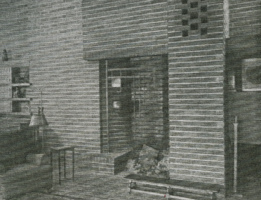
Willey House fireplace as published in Golfer and Sportsman, June 1935
The length of the hook selected effectively regulates the heat by bringing a hanging kettle in or out of proximity to the flames, in the same way, a gas knob governs the flame on a stovetop. This time-tested, rudimentary method of controlled cooking dates to antiquity. The kettle itself does not need to hang directly above the fire. Hanging beside it works as well. The crane allows a kettle to be swung in and away from the embers for fine-tuned regulation of heat. By this reckoning, the Willey House fireplace seems to be outfitted with all the fundamentals of fireside cookery.
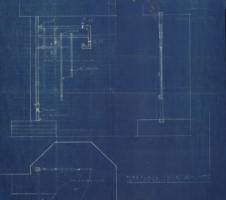
Plan for the Willey House fireplace crane shown with two pothooks rather than three. Credit: Wisconsin Historical Society, John Howe Collection
But just because the basics are in place, is it safe to assume that Frank Lloyd Wright’s fireplace cooking accommodations were actually intended for culinary pursuits? Not really. Think of the fireplace, crane, and cauldron at Fallingwater. Despite the appearance of this elaborate set up, was it intended for culinary use? Was it stagecraft? Or was that magnificent, spigoted kettle just an elaborate ruse, a humidifier disguised as a cook pot? It’s commonly known that a kettle of water boiling over a fire, placed on a stovetop, or resting on a hot radiator, has been a way to humidify a home with steam during the dry winter months. Wright’s own words suggest this specific purpose, in the book Years With Frank Lloyd Wright: Apprentice to Genius by Edgar Tafel. In it Tafel told of Edgar Kaufmann speeding toward Taliesin as Mr. Wright deftly renders
the plans for Fallingwater, all the while issuing a running, room-by-room narration on exactly how the Kaufmanns would live in their new country home. “The warming kettle will fit into the wall here. It will swing into the fire, boiling the water. Steam will permeate the atmosphere. You’ll hear the hiss…” Wright makes his visceral depiction of a thing so practical as to be mundane, sound terrifically romantic. And perhaps romance was the only thing intended. By all accounts, Bear Run with its dramatic waterfall does a perfectly effective job of humidifying the stone masonry house without human intervention. Yet Wright imagines boiling water on the splendid, primordial hearth at Fallingwater.

A contender for the most beautiful fireplace in the world is at Fallingwater. The hearth arises from the tip of a rock that the house is founded upon. Credit: Stan Ecklund
Sure, why not? The question remains, was this fireplace, or any of his others, truly intended for real-life, full-fledged cooking? Well? The historical record is uncharacteristically silent when it comes to mentions of Wrightian fireside cooking. No stories of broths or hearty stews, no coffee brewing, not even so much as boiling water for a tea bag. I’m not saying it’s impossible to imagine that clients attempted to cook over the fire once or twice before retreating to their modern range tops to feed themselves, only improbable that they bothered a second or third time. (Dr. John Christian was a notable exception here). But it’s far more likely that a crane on which to hang a kettle was primarily symbolic, a hint, left by Wright to remind us that all fireplaces had once provided the complementary comforts of life-giving warmth and sustenance. As John Hartford knew, the mere intimation of a cauldron over a crackling fire is apt to stir primal emotions and is enough to evoke the pleasures of a warm, fireside meal even if it is imaginary.

The west fireplace at Wingspread is a Machine Age masterpiece. Credit: Mark Hertzberg
I determined a deeper examination of the fireplaces Wright fitted with cooking apparatuses might help answer my concerns over functionality.
Of the five fireplaces at Wingspread only one, the west fireplace, is equipped with a massive, three-legged cauldron slung from a pivoting armature. It presides over the great hall, which is the hub of this expansive, pinwheel house plan. The bekettled fireplace commands center stage in the quadrant of the great room, designated for dining. A muscular crane arm swings the enormous globe-shaped cauldron into the fire, centered on a semi-circular fire grate that blends seamlessly into the masonry and completes the circle at the base of the cylindrical firebox. The opening of the firebox is capped top and bottom with a stone lintel and hob below. The stained, Cherokee Red concrete of the living room floor extends into the hearth, surreptitiously uniting the fire with the ground plane of the room itself. The massive swiveling globe, literally an infernal machine, creates the impression of a projectile being loaded into a silo to be catapulted and ignited by the fire. The imagined act of igniting the blaze, loading the cauldron, and swinging it into position carries the weight and ceremony of a NASA launch three decades hence! But can it cook beans?
Apocryphal stories do abound, but could these magnificent contraptions really rival a Crockpot? Let’s consider the physical evidence. At Wingspread the kettle hangs too low to the fire grate to allow much room to stack logs. Firewood at the back of the grate is pinched between two hobs that must certainly constrict essential airflow. And one of the two iron hooks hung from the armature is too long to hold the globe-like cauldron above the fire. Find this surprising? Well then, consider this, at Fallingwater, within what is hands down the mother of all fireplaces, there are three iron hooks of progressive length set inline on the crane arm, in addition to the suspended cauldron. They are presumably intended to hang a second or third, smaller kettle, but at least one of the hooks is too long to swing any sort of pot above the fire grate. Hmm. How could it be, that things so intentional in ambition, fail so spectacularly to suit their intended purpose? The answer, I suppose depends on Wright’s purpose. Before we judge him too harshly it is only fair to mention that the as-built state of each fireplace varies to some degree from his rendered plans. In particular, the additional hanging hook and poker that exist in the Wingspread fireplace are not shown in archival renderings. The hob spacing at the back of the firebox is more pinched than was drawn in plan, probably altered in an effort to center the logs beneath the chimney. But even with these as-built modifications, the whole of the west fireplace remains functionally awkward. What does that imply? Let’s find out.
At the Willey House, the handsome, original pot (in absentia), crafted in cast iron, unlike Mr. Glanzer’s sorry stand-ins, was well integrated into the whole of the cooking apparatus. The armature itself is indicative of Wright’s work at his best, in that it is a delicate balance of beauty and function, applied in equal proportions. Like his architectural plans, when examined in flat elevation, the crane reveals itself to be a dynamic work of graphic art. The crane arm is a subordinate composition existing within the dominant design of the living room. Though the fireplace is fully dimensional, the strong parallel lines of the crane’s metalwork stand in sharp contrast to the broad, flat masonry massing of the room, making itself the center of attention, flagrant in its patterning of the iron bars.
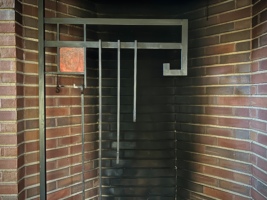
The Willey House fireplace crane has an enameled red square integrated into its design. Credit: Steve Sikora
It possesses a musical quality that is conspicuous. In Frank Lloyd Wright’s fractal universe, speculation has it that the melodious design of the Willey House crane could be interpreted as an abstraction of the “L-shaped” house plan. Perhaps, but more so, like many other aspects of the Willey House, this metalwork bears similarities to something existing within Wright’s own home. The crane appears to be an elaboration of the one in the Taliesin living room fireplace.
Taliesin historian, Keiran Murphy, confirmed the crane in the Taliesin III living room did not exist in the earliest iteration of the house, Taliesin I, which was gutted by the 1914 fire. As to the question of whether a fireplace crane existed in the living room of Taliesin II, she produced a wonderful photo of Wright circa 1922-24. In it, he sits before the hearth in a velvet ensemble. The fireplace, with some masonry variations, resembles the one in the living room of Taliesin III. The crane, though set lower, looks very similar in form to the one in the living room today. This might be Frank Lloyd Wright’s first use of a fireplace crane. Of particular interest is the rather large, egg-shaped kettle hanging over the fire.
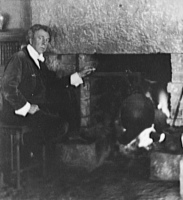
Clad in velvet, Wright sits before the fire in the living room of Taliesin II. A crane and kettle appear in the fireplace. Credit: Maginel Wright Barney, © RMN-Grand Palais (musée d’Orsay) / image RMN-GP
Frank Lloyd Wright’s fireplace armatures tend to exhibit a powerful aesthetic influence over the rooms in which they exist. The presence of boldly mechanistic fireplace cranes at Fallingwater, Wingspread, the Willey House (The Garden Wall) make complete cultural sense as well, given the 1930s time frame. Their overt mechanical qualities and masculine proportions are representative of the Machine Age. All of them were created within 4 years of each other, at the apex of the era. The machine aesthetic at that time was a bellwether of modernity—an expression of the mechanized future that naturally, Wright would assimilate and use to advantage.
READ THE REST OF THE SERIES
Part 1: The Open Plan Kitchen
Part 2: Influencing Vernacular Architecture
Part 3: The Inner City Usonian
Part 4: A Bridge Too Far
Part 5: The Best of Clients
Part 6: Little Triggers
Part 7: Step Right Up
Part 8: A Rug Plan
Part 9: Hucksters, Charlatans, and Petty Criminals
Part 10: Lo on the Horizon
Part 11: Origins of Wright’s Cherokee Red
Part 12: One Thousand Words
Part 13: The Plow that Broke the Plains
Part 14: Separated at Birth
Part 15: Trading Drama for Poetry
Part 16: A Red By Any Other Name
Part 17: Roll Down to Levittown
Part 18: Cherokee Red The Rejoinder
Part 19: Nothing Lasts Forever
Part 20: The Struggle
Part 21: Giving What They Had to Give
Part 22: Calling the Kettle Back—Chapter 1: The Kettle
Part 22: Calling the Kettle Back—Chapter 2: The Crane
Part 22: Calling the Kettle Back—Chapter 3: Plagued By Fireplaces
Part 22: Calling the Kettle Back—Chapter 4: A Heritage of Cooking Fires
Part 22: Calling the Kettle Back—Chapter 5: Benefits of the Fireplace
Part 22: Calling the Kettle Back—Chapter 6: Transcendental Flame
Part 22: Calling the Kettle Back—Chapter 7: Repatriation


